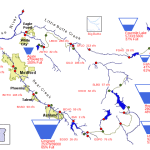APRC Approves $20,000 for Potable Water at the Golf Course

Analysis and Opinion by Dean Silver
Faced with declining revenues due to poor conditions at the Oak Knoll Golf Course, the Ashland Parks and Recreation Commission voted unanimously to “find” $20,000 to purchase up to 400,000 gallons of potable city water to irrigate the rapidly deteriorating greens at the course at the September 14 business meeting.
Director Michael Black stated, “staff is recommending that the commissioners authorize me to look for $20k that we can bring from another line item in order to pay for the water at the golf course to be able to water the greens for the next 35 days.”
Commission Jim Bachman asked, “where would this money come from?”
Michael Black’s response was, ““Well, I, there’s a couple of places that I have in mind. I can’t tell you right this second…. It will be impactful somewhere, there isn’t $20k of extra money laying out there.”
Commission Jim Bachman noted, “we need a very good reason to invest more water in the course…. to continue to try to shoestring this thing in my view isn’t prudent financial management.”
Black stated that the revenue from the golf course for July and August combined was $29,000.

Reversal of Policy
At the May 4, 2022 APRC study session, when it was revealed that APR management had been watering the course with potable water at a cost of over $72,000, Black stated, “I’m not going to come back and ask you to water the golf course with city water. I’m not going to. There’s not money to do that.… I can guarantee you, I’m not coming back to you to ask you, or recommend that we use culinary water in a year where we’re probably going to be on water curtailment, whether it’s mandatory or suggested, I’m not going to suggest that we use culinary water to water the golf course.”
Despite that statement, Commissioner Bell suggested that there be a motion at the next business meeting stating that “culinary” water would not be used for the golf course. Commissioner Eldridge “echoed” his sentiments: “I want to just state for the record that, I know it’s a study session, but I, my personal feeling is that I do not want culinary water to be used at all, for any reason, on the golf course, today, in the future, indefinitely, and if a motion is necessary to insure that’s the case, I’d be willing to do that at the next meeting if it’s possible…”
Black interrupted, “It’s only necessary if you don’t trust me, cause I will not spend money on culinary water at the golf course, I’m telling you that right now… (crosstalk with Bell)… the motion could help in supporting me, but I don’t, there’s no intent of using any city water at all, there is no intent at all. If you want to make the motion to support me that’s great, and to just make sure that the public realizes that this is the situation, and you could actually give me some cover, but it’s up to you.”
A motion to “suspend watering Oak Knoll golf Course with potable water unless the policy is reversed” was unanimously approved by the Commission at their May 11, 2022 business meeting.

Justification for Reversal of Policy?
At the September 14 business meeting, photos were displayed of several of the greens at the course. They are essentially ruined. How did this happen? TID water was available at the golf course for six weeks this summer, from July 8 through August 19. The greens were showing signs of extreme distress long before the water began to run. Was the available water devoted to resuscitating the greens? If so, it did not work. What good did six weeks of TID irrigation accomplish?
The greens are the most expensive and labor intensive features of a golf course to maintain. If they were suffering, why were they not substantially repaired with the water that was available for the summer? If they were not salvageable when TID water was available, what makes anyone think that they are salvageable with one month of additional potable water?
This appears to be a desperate, last ditch attempt to salvage what is left of the greens. The greens need to be replanted and restored; great expense and copious amount of water will be required. If the water doesn’t come from the heavens, where will it come from? When it does rain, will it be enough and at the right times to benefit the new grass?

“Recommended by Staff”
At APRC meetings, we often hear about recommendations from staff. What does that mean? Clearly, it means “recommended by Michael Black”. He sets policy and creates actions for the Commission to approve. As evidenced at every meeting, Black makes suggestions, and the Commission approves them, usually (but not always) unanimously. This is the definition of a rubber stamp.
This is exactly backwards. APRC is supposed to set policy, and staff if supposed to carry out those policies. And yet, virtually no ideas originate from the Commission; they invariably come from “staff”, i.e., Michael Black. This is not the way the Parks and Rec Department is supposed to be managed.
The problem is exacerbated by the obvious incompetence of the director. He is clearly not capable of guiding the department during this time of limited financial and environmental resources. He has let the golf course deteriorate to a condition where golfers are choosing to play elsewhere. He has let it deteriorate to a state where it will require significant infusions of resources to be brought back to playable condition.
And even if the course can be restored, there is little likelihood that it will be able to be maintained.

“Find the Money”
Where will the $20,000 that “staff” recommended be spent on potable water for irrigation come from? As noted previously, Black stated, “It will be impactful somewhere, there isn’t $20k of extra money laying out there.”
Examination of the golf course budget doesn’t give many clues. There was $28,563.79 left in the budget for water for the golf course as of August 30. That raises a serious question about how the Parks department expenses are being tracked.
The golf course budget for water for FY 2022 was $29,000. APR spent $80,194.56. The budget for water was exceeded by $51,194.56 in FY 22, the first year of the biennial budget. Since the city runs on a biennial budget, that deficit should have carried over to FY 23. Yet, the finance department shows the original $29,000 budgeted for FY 23. This is not proper accounting.
But regardless of inconsistencies in the financial reporting, where will that $20K come from? There was $10,000 available for “grounds care” and $7,200 for fertilizer. $3,453.55 was remaining for “general maintenance”.
Last year the charge for TID water was $4,795.40. At least that much must be reserved to pay for this bill this year; it should be considered encumbered.
In short, there is no money in the golf course budget to cover this expense for water. It will have to come from somewhere else in the APR budget. What will contribute that money? What other program or service or operation will suffer in order to finance this expenditure for water? What other program will be expected to sacrifice funding in order to fund this misguided attempt to save the golf course greens?


Other Golf Course Actions
As well as the discussion of water, Michael Black solicited a motion from the commissioners to “consider entering into an agreement with an outside party to manage the course”. Michael Black claims that there are unnamed parties interested in this approach. It would require a request for proposals (RFP). It indicates that he is not hopeful about APR’s ability to operate the golf course in the future.
Bachman moved “to direct staff to pursue the RFP approach to possibly forming a partnership of any kind to run the golf course.” Julian Bell seconded. The motion passed unanimously.
The word desperation recurs. The commission appears desperate to maintain the golf course as a golf course, no matter what it takes. If that means a public/private partnership, they are willing to explore it. It is clear that the Parks and Rec department does not have the financial resources nor the water resources necessary to operate and maintain the golf course.
Is it likely that any private entity will be interested in operating a golf course that perpetually loses money, and doesn’t have adequate water supplies? Time will tell.
The final suggestion from Michael Black was to consider closing the course while rehabilitation was being performed. As is typical of his management style, he offered that suggestion, and then recommended against it. No action was taken in that regard.


What’s the Point?
You don’t have to be a landscape expert or golfer to realize that the greens at Oak Knoll are ruined beyond redemption. A one month application of water will not repair them. They basically need to be rebuilt.
So why go thru the motions of applying 400,000 gallons of potable water to the greens for one month at the cost of $20,000? Is it an unwillingness to admit failure to maintain the course at a playable level? Is it is misguided attempt to make the course more attractive to a potential external operator?
Whatever the thinking behind this utter waste of money and resources, it is wrong, and will not pay off. It is just one more example of the egregious mismanagement of the parks department and our city’s precious park lands by Michael Black.

The Bottom Line
For more background, read What’s New With the Golf Course? and The Rest of the Golf Course Water Story. They explain the background that has led up to this unfortunate situation. You can watch the September 14 APRC business meeting here.
A visit to the golf course today at about noon, a sunny, seventy degree day, a perfect day for golf, showed fewer than ten cars in the parking lot and very few players visible on the links. Obviously, most Ashland golfers have already given up on the Oak Knoll Golf Course.
It is clear that Michael Black has reneged on his solemn promise to not use potable water to irrigate the golf course. APRC has gone along with this misguided attempt to rescue the greens at the golf course. It is too little, too late. It is a waste of taxpayer money, and expensive potable water. It is a betrayal of the trust of the taxpayers and citizens of Ashland.
All photos by Dean Silver 9/16/2022






